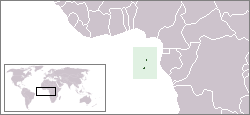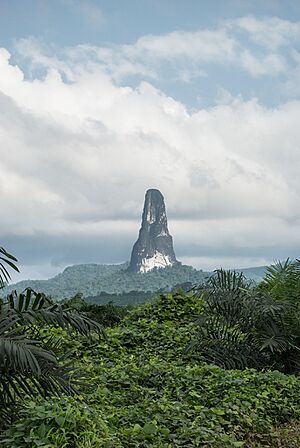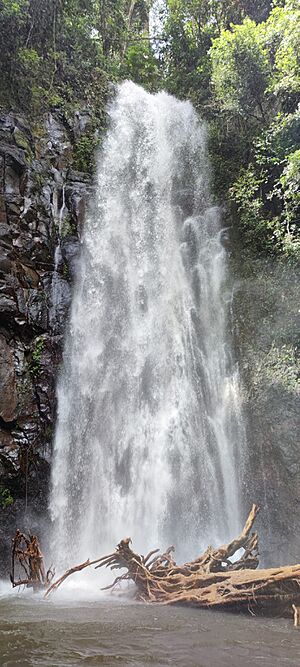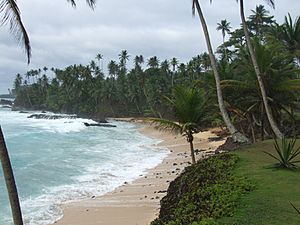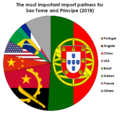São Tomé and Príncipe facts for kids
Quick facts for kids
Democratic Republic of São Tomé and Príncipe
República Democrática de São Tomé e Príncipe (Portuguese)
|
|
|---|---|
|
|
|
|
Motto: "Unidade, Disciplina, Trabalho"
("Unity, Discipline, Labour") |
|
|
Anthem: "Independência total"
("Total Independence") |
|
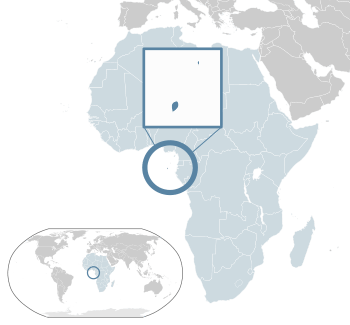
Location of São Tomé and Príncipe (dark blue)
in Africa (light blue) |
|
| Capital and largest city
|
São Tomé 0°20′N 6°44′E / 0.333°N 6.733°E |
| Official languages | Portuguese |
| Recognised regional languages |
|
| Religion
(2020)
|
|
| Demonym(s) |
|
| Government | Unitary semi-presidential republic |
| Carlos Vila Nova | |
| Américo Ramos | |
| Legislature | National Assembly |
| Independence | |
|
• from Portugal
|
12 July 1975 |
| Area | |
|
• Total
|
964 km2 (372 sq mi) (171st) |
|
• Water (%)
|
Negligible |
| Population | |
|
• 2023 estimate
|
220,372 (175th) |
|
• Density
|
199.7/km2 (517.2/sq mi) (69th) |
| GDP (PPP) | 2024 estimate |
|
• Total
|
|
|
• Per capita
|
|
| GDP (nominal) | 2024 estimate |
|
• Total
|
|
|
• Per capita
|
|
| Gini (2017) | ▲ 56.3 high |
| HDI (2022) | medium · 141st |
| Currency | Dobra (STN) |
| Time zone | UTC (GMT) |
| Date format | dd/mm/yyyy |
| Driving side | right |
| Calling code | +239 |
| ISO 3166 code | ST |
| Internet TLD | .st |
The Democratic Republic of São Tomé and Príncipe is the second smallest country in Africa. It is made up of two islands: São Tomé and Príncipe.
These islands are about 140 kilometers (87 miles) apart. They are located off the northwestern coast of Gabon. São Tomé is about 250 km (155 mi) away, and Príncipe is about 225 km (140 mi) away.
The islands were once a colony of Portugal. They became independent in July 1975. Portuguese is the official language spoken here.
Contents
History of São Tomé and Príncipe
The islands were not lived on until 1470. That's when Portuguese explorers João de Santarém and Pedro Escobar discovered them. Over the 16th century, Portuguese people gradually settled and colonized the islands. They became an important center for the Atlantic slave trade.
The rich volcanic soil and warm weather near the equator were perfect for growing sugar. Later, crops like coffee and cocoa became important. These farms relied heavily on enslaved people from Africa.
On February 3, 1953, a sad event called the Massacre of Batepá happened. Thousands of local people were killed by Portuguese settlers. This happened because of a disagreement about hiring workers. After slavery ended, the Portuguese needed workers for their farms. Local people refused to work under conditions that felt like slavery to them.
The movement for the islands' independence began in the late 1950s. A group called the CLSTP (Committee for the Liberation of São Tomé and Principe) was formed. This group later changed its name to MLSTP (Movement for the Liberation of São Tomé and Príncipe). This became the first political party after the islands gained independence on July 12, 1975.
Government and Politics
When São Tomé and Príncipe became independent, Manuel Pinto da Costa was named the first president. He was the leader of the MLSTP party. At first, the country had a single-party system. This means only one political party was allowed.
In the 1990s, the country made big political and economic changes. They switched to a multi-party system, allowing many political parties. Miguel Trovoada was then elected as the second president.
The president is chosen by the people in an election. They serve for five years and can be re-elected once. The prime minister is chosen by the president. The prime minister then picks 13 ministers to form the cabinet.
The cabinet and the National Assembly share the power to make laws. The court system, called the judiciary, is separate and independent.
Some of the main political parties in the country are:
- The Movement for the Liberation of São Tomé and Príncipe (MLSTP)
- The Party of Democratic Convergence (PCD)
- The Independent Democratic Action (ADI)
- The Democratic Movement Force for Change - Liberal Party (MDFM-PL)
Regions and Cities
São Tomé and Príncipe is divided into two main areas called provinces. These are Príncipe and São Tomé.
These provinces are further divided into seven smaller areas called districts. Six districts are on São Tomé Island, and one is on Príncipe. Príncipe has had its own self-government since April 29, 1995.
Main Cities and Towns
The capital city is São Tomé. It is also the largest city. Here are some of the main cities and towns:
- São Tomé (the capital)
- Santo Amaro
- Neves
- Santana
- Trindade
- Santa Cruz
- Pantufo
- Guadalupe
- Santo António
- Santa Catarina
- Porto Alegre
Geography and Landscape
The two islands of São Tomé and Príncipe were formed about 30 million years ago. This happened because of volcanoes deep under the ocean. The rich volcanic soil, which is about 3 million years old, has been used for farming since colonial times.
These islands are located in the Atlantic Ocean, near the Gulf of Guinea. They are Africa's second-smallest country. Both islands are part of a chain of volcanoes that also includes other islands and Mount Cameroon.
São Tomé Island is about 50 kilometers (31 miles) long and 30 kilometers (19 miles) wide. It is the more mountainous island. Its highest point is Pico de São Tomé, which is 2,024 meters (6,640 feet) tall. Príncipe Island is about 30 kilometers (19 miles) long and 6 kilometers (4 miles) wide. Its highest point is Pico de Príncipe, at 948 meters (3,110 feet).
Both islands have fast streams flowing down the mountains through thick forests and farms to the sea. The Equator line passes just south of São Tomé Island, going through a tiny islet called Ilhéu das Rolas.
The Pico Cão Grande (Great Dog Peak) is a famous volcanic peak in southern São Tomé. It rises over 300 meters (984 feet) above the land around it. Its top is 663 meters (2,175 feet) above sea level.
Climate and Weather
The weather in São Tomé and Príncipe is mostly affected by its location near the equator. It is also influenced by monsoon winds, the warm Guinea Current, and its mountains.
At sea level, the climate is tropical. This means it is hot and humid. The average yearly temperature is about 26°C (79°F). The temperature rarely goes above 32°C (90°F). In the higher mountains, the average yearly temperature is about 20°C (68°F), and nights are usually cool.
How much rain falls each year changes a lot. It can be as much as 7,000 millimeters (276 inches) in the mountain cloud forests. In the northern lowlands, it can be as little as 800 millimeters (31 inches). The rainy season lasts from October to May.
Plants and Animals
The islands are part of a special area called the São Tomé, Príncipe, and Annobón moist lowland forests. This means they have unique plants and animals.
São Tomé and Príncipe does not have many native mammals. However, it has some unique bats and the São Tomé shrew. The islands are home to many birds and plants found nowhere else. These include the world's smallest ibis (the São Tomé ibis) and the world's largest sunbird (the giant sunbird). You can also find the rare São Tomé fiscal and several giant types of Begonia plants.
The islands are also an important place for marine turtles to lay their eggs. This includes the hawksbill turtles.
Economy and Trade
Since the islands were discovered, their economy has been based on farming and fishing. Today, the main crop is cacao. Cacao makes up 95% of the country's exports. Other exports include copper, palm oil, and coffee. Tourism is another growing part of the economy. The government and private businesses are working to make it bigger.
After gaining independence, the government took control of the economy. But in the early 1990s, they started to change things. They began to allow private businesses to own parts of the economy.
Today, the government's money mostly comes from help from other countries and groups. These include the UN Development Programme and the World Bank.
The main countries that buy products from São Tomé and Príncipe are Portugal (51%), France (14%), Angola (11%), and Japan (10%).
In 2001, oil was found in the waters near the islands. After talks with Nigeria, the two countries agreed to share the oil development. In 2003, they opened an area for companies to bid on. However, oil is not yet being taken out of the ground.
People and Culture
In May 2018, the total population was about 201,800 people. Most people (about 193,380) live on São Tomé Island. About 8,420 people live on Príncipe Island. The population grows by about 4,000 people each year.
Almost everyone living on the islands today is descended from people brought there by the Portuguese. These people came from different countries starting in 1470. In the 1970s, many Portuguese residents left the islands. At the same time, many São Tomé refugees came from Angola.
There are several different groups of people on São Tomé and Príncipe:
- Luso-Africans: These are people of mixed Portuguese and African heritage. They are descendants of Portuguese settlers and enslaved Africans brought from places like Benin, Gabon, and Angola. They are also called filhos da terra, meaning "children of the land."
- Angolares: These people are believed to be descendants of Angolan enslaved people who survived a shipwreck in 1540. They now mostly earn a living by fishing.
- Forros: These are descendants of enslaved people who were set free when slavery was abolished.
- Serviçais: These are workers from Angola, Mozambique, and Cape Verde who come to the islands for temporary work.
- Tongas: These are children of serviçais who were born on the islands.
- Europeans: Most of these are from Portugal.
- Asians: Most are Chinese, including some Macanese people who have mixed Portuguese and Chinese backgrounds from Macau.
Most people on the islands belong to the local branch of the Roman Catholic Church. This church has strong ties to the church in Portugal.
Languages Spoken
Portuguese is the official language of São Tomé and Príncipe. About 98.4% of people speak it, and for many, it is their first language. Portuguese has been spoken on the islands since the late 1400s.
Other languages taught in schools include French (spoken by 6.8%) and English (spoken by 4.9%).
Cultural Traditions
The culture of São Tomé and Príncipe is a mix of Portuguese and African influences. Some traditional dances on the islands are Ússua, Socopé, Dêxa, and Puita.
Tchiloli, Danço Congo, and Auto dos Floripes are public theater performances. These show the Portuguese cultural history.
Important figures in the islands' history and culture include King Amador and Alda Espírito Santos (1926-2010).
Food and Cuisine
Staple foods in São Tomé and Príncipe include fish, seafood, beans, maize, breadfruit, and cooked banana. Tropical fruits like pineapple, avocado, and bananas are also a big part of the food.
People in São Tomé and Príncipe often use hot spices in their cooking. Coffee is used in different dishes as a spice or seasoning. Breakfast often includes leftovers from the night before. Omelettes are also a popular breakfast choice.
Images for kids
-
Capture of São Tomé by Cornelis Jol of the Dutch West India Company in 1641.
-
The Our Lady of Grace Cathedral of São Tomé
See also
 In Spanish: Santo Tomé y Príncipe para niños
In Spanish: Santo Tomé y Príncipe para niños




